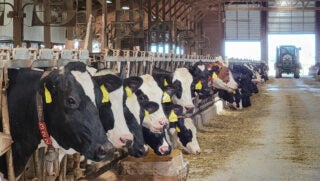On Thursday, Agriculture Secretary Tom Vilsack announced that the government will compensate farmers for 90 percent of the value of milk lost due to H5N1 avian flu infections in their dairy cows. “We aim to support our producers in every possible way as they face this emerging animal health issue,” Vilsack stated.
Since the initial detection of the H5N1 virus in dairy cattle in Texas three months ago, bird flu has been identified in 132 dairy herds across 12 states, from Idaho to North Carolina. Additionally, three dairy farm workers have contracted mild cases of bird flu from infected cows.
Starting Monday, dairy farmers can apply for payments through the Emergency Livestock Assistance Program (ELAP), coinciding with the USDA’s publication of the aid regulation. The compensation will be calculated at 90 percent of the value of decreased milk production per cow over a 28-day period, using the all-milk price, a U.S. average updated monthly, as the benchmark.
Bird flu generally affects older lactating cows, causing symptoms like fever, loss of appetite, and significantly reduced milk output. Most cows recover within a couple of weeks. USDA scientists estimate that about 10 percent of cows in an infected herd fall ill, with culling and mortality rates at approximately 2 percent.
Vilsack avoided answering directly whether farmers should be reimbursed for culled cows, stating that it is challenging to determine the exact reasons for sending a cow to slaughter. “We believe we are providing the most effective assistance” through payments for reduced milk production, he said.

The USDA’s financial support to combat the H5N1 virus includes up to $28,000 over three months for farmers with infected herds to enhance biosecurity, obtain protective gear for workers, and cover veterinary treatment and testing costs. Farms free of the disease are eligible for up to $1,500 for biosecurity improvements and up to $2,000 for testing cows for the virus.
Ohio and North Carolina have joined Kansas, Nebraska, New Mexico, and Texas in a pilot program for voluntary weekly testing of milk from bulk coolers for the H5N1 virus. Farms testing negative for three consecutive weeks are exempt from a USDA requirement to test cattle for bird flu before interstate shipping.
The USDA aims to “isolate and eradicate this disease” by preventing its spread, Vilsack emphasized.
Created in 2008, ELAP covers losses to livestock, honeybees, and farm-raised fish due to disease and adverse weather. While there is no cap on payments to a producer, eligibility is limited to those with an adjusted gross income of less than $900,000 per year, according to an ELAP fact sheet.
Bird flu outbreaks have surged among domestic flocks this spring, resulting in the deaths of 8.8 million birds in April and 5.9 million in May. This month, 460,000 birds have died, according to a USDA database. Since the H5N1 virus emerged in February 2022, 97.2 million birds in domestic flocks, primarily egg-laying hens and meat turkeys, have died from the virus or been culled to prevent its spread.
»Related: Expert delves into the complexities of HPAI and milk consumption


